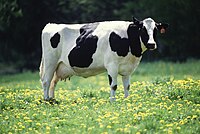
Photo from wikipedia
Abstract The effects of feeding lucerne hay (Medicago sativa) and or barley grain to grazing reproducing Angora does on birth weight, live weight, body condition, quality and production of milk… Click to show full abstract
Abstract The effects of feeding lucerne hay (Medicago sativa) and or barley grain to grazing reproducing Angora does on birth weight, live weight, body condition, quality and production of milk and mohair and gastrointestinal parasitism were investigated in does and kids. The design was supplementation for the last 8 weeks prepartum to 8 weeks postpartum with 5 levels of whole barley grain (GL: 0, 115, 230, 345, 460 g/d/doe) × 2 levels of hay supplementation (HL, 380 g/d/doe 8 weeks prepartum, 0 g/d postpartum; HH, 830 g/d/doe 8 weeks prepartum, 800 g/d/doe 8 weeks postpartum) × 2 randomised blocks. This provided 20 experimental plots, 10 for each level of hay and 4 for each GL. Each plot contained one dry doe, three single litter does, and one twin litter doe. Pastoral conditions were poor with low availability of green pasture until late spring. Does kidded in early August. Important results were: GL affected the birth weight of twin kids (+15%) but not of single kids; GL affected kid live weight, milk production, composition and secretion of milk solids, total mohair production and some mohair quality measures but GL increased fibre diameter and incidence of medullated fibres in kid mohair; optimum performance at day 40 of lactation was GL 345 which produced 2325 g/d milk corrected to 4% fat. HH increased secretion of milk protein and total solids compared with HL. Twin litters had greater persistence in lactation to day 100 of lactation compared with single litters. There was evidence that high levels of barley feeding reduced faecal egg count. Dry does gained more live weight, grew 26% more mohair which was 1.7 μm coarser compared with does with single litter. The results indicate that feeding lucerne hay even under adverse seasonal conditions was of little value. The lactation performance of these grazing Angora does was substantially less than their potential. Optimum barley feeding was GL 345 g/d/doe. There was evidence of substitution of pasture for hay. The results quantified the production responses and penalties of Angora does when litter size was increased from non-pregnant status (zero) to 2.
Journal Title: Small Ruminant Research
Year Published: 2020
Link to full text (if available)
Share on Social Media: Sign Up to like & get
recommendations!